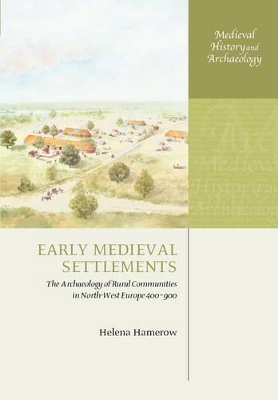Medieval History and Archaeology
2 total works
In the course of the fifth century, the farms and villas of lowland Britain were replaced by a new, distinctive form of rural settlement: the settlements of Anglo-Saxon communities. This volume presents the first major synthesis of the evidence - which has expanded enormously in recent years - for such settlements from across England and throughout the Anglo-Saxon period, and what it reveals about the communities who built and lived in them, and whose daily lives
went almost wholly unrecorded. Helena Hamerow examines the appearance, 'life-cycles', and function of their buildings; the relationship of Anglo-Saxon settlements to the Romano-British landscape and to later medieval villages; the role of ritual in daily life; what distinguished 'rural' from 'urban' in
this early period; and the relationship between farming regimes and settlement forms. A central theme throughout the book is the impact on rural producers of the rise of lordship and markets and how this impact is revealed through the remains of their settlements. Hamerow provides an introduction to the wealth of information yielded by settlement archaeology and to the enormous contribution that it makes to our understanding of Anglo-Saxon society.
went almost wholly unrecorded. Helena Hamerow examines the appearance, 'life-cycles', and function of their buildings; the relationship of Anglo-Saxon settlements to the Romano-British landscape and to later medieval villages; the role of ritual in daily life; what distinguished 'rural' from 'urban' in
this early period; and the relationship between farming regimes and settlement forms. A central theme throughout the book is the impact on rural producers of the rise of lordship and markets and how this impact is revealed through the remains of their settlements. Hamerow provides an introduction to the wealth of information yielded by settlement archaeology and to the enormous contribution that it makes to our understanding of Anglo-Saxon society.
The excavation of settlements has in recent years transformed our understanding of north-west Europe in the early Middle Ages. We can for the first time begin to answer fundamental questions such as: what did houses look like and how were they furnished? how did villages and individual farmsteads develop? how and when did agrarian production become intensified and how did this affect village communities? what role did craft production and trade play in the rural
economy?
In a period for which written sources are scarce, archaeology is of central importance in understanding the 'small worlds' of early medieval communities. Helena Hamerow's extensively illustrated and accessible study offers the first overview and synthesis of the large and rapidly growing body of evidence for early medieval settlements in north-west Europe, as well as a consideration of the implications of this evidence for Anglo-Saxon England.
SERIES DESCRIPTION
The aim of the series is to reflect the creative dialogue that is developing between the disciplines of medieval history and archaeology. It will integrate archaeological and historical approaches to aspects of medieval society, economy, and culture. A range of archaeological evidence will be presented and interpreted in ways accessible to historians, while providing a historical perspective and context for those studying the material culture of the period.
economy?
In a period for which written sources are scarce, archaeology is of central importance in understanding the 'small worlds' of early medieval communities. Helena Hamerow's extensively illustrated and accessible study offers the first overview and synthesis of the large and rapidly growing body of evidence for early medieval settlements in north-west Europe, as well as a consideration of the implications of this evidence for Anglo-Saxon England.
SERIES DESCRIPTION
The aim of the series is to reflect the creative dialogue that is developing between the disciplines of medieval history and archaeology. It will integrate archaeological and historical approaches to aspects of medieval society, economy, and culture. A range of archaeological evidence will be presented and interpreted in ways accessible to historians, while providing a historical perspective and context for those studying the material culture of the period.

